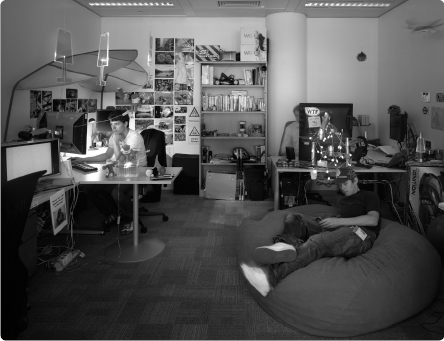Communicating through the Environment
A final way in which we communicate nonverbally is through our environment, the physical features of our surroundings. As the photo of the Google office on the right illustrates, our environment envelops us, shapes our communication, and implies certain things about us, often without our realizing it.

Examine how these Google employees have set up their shared office space. What do their choices in semifixed features like personal decorations, wall art, furniture, and lighting communicate about them?
Chris Gascoigne/VIEW/Livedinimages.com
Two types of environmental factors play a role in shaping interpersonal communication: fixed features and semifixed features (Hall, 1981). Fixed features are stable and unchanging environmental elements such as walls, ceilings, floors, and doors. Fixed features define the size of a particular environment, and size has an enormous emotional and communicative impact on people. For example, the size of structures communicates power, with bigger often being better. In corporations, it’s often assumed that larger offices equal greater power for their occupants, and, historically, the square footage of homes has communicated the occupant’s degree of wealth.
Semifixed features are impermanent and usually easy to change; they include furniture, lighting, and color. We associate bright lighting with environments that are very active and soft lighting with environments that are calmer and more intimate. Color also exerts a powerful effect on our mood and communication: we experience blues and greens as relaxing, yellows and oranges as arousing and energizing, reds and blacks as sensuous, and grays and browns as depressing (Burgoon et al., 1996).
Self-Reflection
Look around the room you’re in right now. How does this room make you feel? How do the size of the space, furniture, lighting, and color contribute to your impression? What kind of interpersonal communication would be most appropriate for this space—personal or professional? Why?
Question
Self-Reflection
LearningCurve